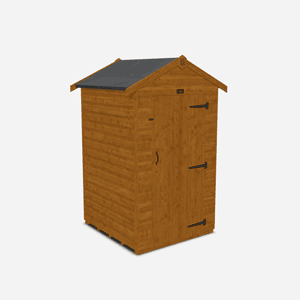How to Ventilate a Shed or Log Cabin
Published: 05/08/2020

Garden buildings like sheds, log cabins, and summerhouses are a brilliant way to add storage or create extra living space in your garden, but without proper airflow, they can quickly become damp, uncomfortable, and less enjoyable to use. The good news is that shed ventilation doesn’t need to be complicated. From choosing the right placement to installing vents or turbines, there are plenty of straightforward ways to keep your building fresh and functional all year round.
In this guide, we’ll explain why shed ventilation matters, outline common warning signs of poor airflow, and walk you through the best ways to ventilate sheds and other garden buildings of all sizes.
Why is Shed Ventilation Important?
Good airflow is crucial in any timber building. Without it, moisture builds up and creates the perfect environment for mould, mildew, and rot. Over time, this can damage the structure of your building, reduce its lifespan, and even affect anything you store inside.
Here are some common signs that your shed, log cabin, or summerhouse may need better ventilation:
Good ventilation is the secret to making any timber building last longer. Without it, moisture gets trapped, creating the ideal conditions for mould, mildew, and rot to take hold. Not only does this affect the structure, but it also impacts what’s stored inside – from rusting tools to damp furniture.
Here are some clear signs that your shed or log cabin may need better airflow:
- Condensation – water droplets forming on walls, windows, or ceilings
- Damp odour – a musty smell that lingers inside the building
- Warped or rotting wood – timber that feels soft, swollen, or uneven
- Mould or mildew – dark patches on surfaces or belongings
- Rusting tools and equipment – caused by excess humidity
Prevention is always easier than cure, so keeping on top of ventilation and treating the timber regularly will save you time, money, and effort in the long run.

If you spot any of the above, it’s time to look at ways of improving ventilation in your shed or garden building.
Small–Medium Shed Ventilation Options
For smaller sheds (up to around 60 sq. ft.), passive solutions are often enough to keep the air moving. Here are some of the most effective methods:
Open Shed Doors and Windows Regularly
The simplest way to ventilate a shed is by creating a cross-breeze. On dry days, open doors and windows to flush out stale air and let moisture escape. Even a short daily airing can make a big difference.

Milne Log Cabin | 44mm Garden Log Cabins | Tiger Sheds

A stable door is great way to ventilate your shed.
Have you seen the How to Install an Opening Window in your Tiger Shed video?
Install Vents (Wall & Ridge)
Passive wall or ridge vents allow fresh air to circulate continuously, even when the shed is closed. Fit them on opposite sides of the shed (ideally near the gables) to encourage a steady flow. Keep vents clean and free of cobwebs or debris to ensure maximum efficiency.
Fit Turbines
Roof turbines, also known as whirligigs, are powered by the wind. They pull damp air out of the shed and replace it with fresh air, making them a low-maintenance, eco-friendly option.
Treat the Interior
Protecting the timber from the inside is just as important as creating airflow. Regularly apply wood preservative or anti-fungal treatments to help combat the effects of condensation and keep mould at bay.
Tiger Tip - When installing your shed, leave at least two feet of clearance around the building. This gap improves air circulation and prevents surrounding plants or fences from transferring excess moisture onto the walls.

Browse our full range of garden sheds to find a design that suits your space.
How to Ventilate Large Sheds & Garden Buildings
Bigger garden buildings like large sheds, log cabins, and summerhouses can sometimes need more than just passive ventilation. Because there’s more air to circulate, you’ll want solutions that work consistently and cover the whole space. Here are some of the most effective options:
Install Skylights
Roof windows or skylights don’t just brighten up your garden room – they also provide natural ventilation when opened. Ideal for hobby rooms, offices, or gyms, skylights help reduce condensation while giving you control over airflow.
Electric Fans
For airtight spaces or buildings used frequently, electric fans provide reliable, active ventilation. They work by drawing stale air out and pulling fresh air in, helping to maintain a healthier environment. Fans can be powered via mains electricity or solar panels and should be positioned opposite vents for maximum circulation.
Wall & Roof Vents
Just like with smaller sheds, wall and roof vents are a simple but effective way to keep air moving. In larger buildings, multiple vents placed at different heights create a stronger airflow path. This combination helps keep interiors fresh, even when doors and windows are shut.
Heating & Ventilation Together
If you’re spending a lot of time inside a log cabin or garden room, pairing heating with ventilation is essential. Heating helps reduce condensation by raising air temperature, while ventilation removes the moisture. Together, they keep the environment comfortable and damp-free.
Tiger Tip: For larger buildings, check vents, fans, and skylights seasonally. Keeping them clean and free from debris will make sure your ventilation system works efficiently year-round.
Conclusion
Whether you’re using a small storage shed or a large, insulated cabin, ventilation is one of the most effective ways to protect your investment. It prevents damp and mould, extends the life of your building, keeps contents safe, and creates a healthier, more comfortable space to enjoy.
Regular maintenance and smart placement, combined with the right ventilation method, will keep your garden building at its best for many years to come.






